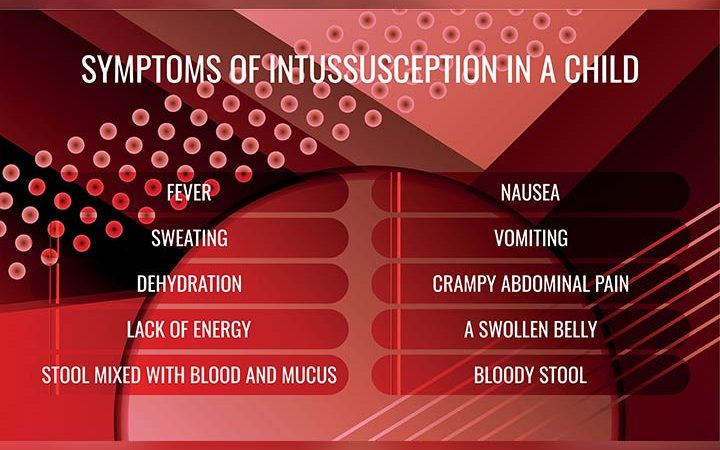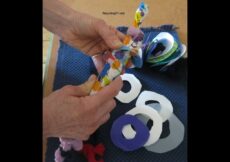Intussusception is a condition in which one part of the intestine slides or telescopes inside the other part. This may occur anywhere in the gastrointestinal tract. However, the junction between small and large intestines (ileocecal junction) often has a higher risk of telescoping than other segments.
Intussusception can cause intestinal blockage (obstruction) in babies. This may also reduce blood flow in the affected intestinal segment, leading to necrosis and infection of the bowel tissue. In addition, babies can also develop severe dehydration.
Read this post to know about the causes, symptoms, complications, treatment, and prognosis of intussusception in babies.
Signs And Symptoms Of Intussusception In Babies
Sudden severe abdominal pain (belly pain) can cause a baby to cry loudly during intussusception. This can be like colic for the first time, but the pain becomes frequent gradually. Babies may bend their knees, act irritable, or cry due to pain. Other symptoms and signs of intussusception may include (1):
- Blood in the stool
- Stool may have the red, jelly-like appearance
- Vomiting
- Fever
- Bile vomiting
- Lethargy or extreme tiredness
- Diarrhea
- Swollen abdomen
- Dehydration signs
Babies may pass a normal stool after a pain episode. But, the next stool may have a blood or red, jelly-like appearance (2). Symptoms of intussusception may vary in each baby and often look like other medical conditions. Therefore, it is recommended to seek immediate medical care if your baby has symptoms and signs of intussusception.
Risk Factors And Causes Of Intussusception
The exact cause of intussusception is not known. According to the Children’s Hospital of Philadelphia, boys develop intussusception four times more than girls, and 80% of cases occur in babies younger than two years old. However, it is rare in newborns. The following factors are believed to be responsible for intussusception in some babies (3).
- Viral infections
- Intestinal polyps or other abnormalities in the intestines
- Resent intestinal surgery
Most babies with intussusception may not have any of these conditions. A genetic basis of intussusception is suggested based on the anatomical factors in cases of idiopathic intussusception (unknown cause) in some families (4). However, acquired agents, such as viral infections, could also occur in families.
Complications Of Intussusception In Babies
If left untreated, intussusception can cause severe complications and often endanger a baby’s life. Possible complications may include (5):
- Internal bleeding
- Peritonitis, a severe infection of the abdominal wall
- Necrosis (death) of intestinal tissues
- Infection of the intestines
- Sepsis or SIRS when the infection spread to the bloodstream, and the body responds to the infection
- Shock-causing life-threatening changes in vitals such as pulse, breathing, and blood pressure
Never ignore or give pain medications to infants and children complaining of sudden, severe abdominal pain. This may mask the pain and delay medical care, complicating into an emergency eventually.
Diagnosis Of Intussusception
Health history, including details of symptoms and physical examination, can help a pediatrician suspect intussusception in babies. The following imaging tests are done to visualize the abdominal organisms and intestines (1) (6).
- Abdominal X-ray examination may show a soft mass in the abdomen with signs of bowel obstruction in infants.
- Abdominal ultrasound helps to visualize the tissues, organs, and blood vessels in the abdominal cavity. The telescoped intestine can cause echogenic or hypoechogenic bands on ultrasound images called target sign, doughnut sign, or bull’s eye sign. This may also create a pseudokidney appearance on the image.
- Barium swallow and upper GI series is abdominal radiography after swallowing barium contrast. This may help the doctor examine upper GI (gastrointestinal) organs such as the esophagus (food pipe), stomach, and duodenum (initial part of the small intestine).
- Lower GI series or barium enema uses barium contrasts through the rectum to visualize bowels on X-ray.
In some babies, the intussusception fixes itself during a barium enema. This may occur due to the pressure on the intestine while barium is introduced into the intestines.
Treatment For Intussusception In Babies
The following treatments are given to a baby before beginning the treatment for intussusception.
- Intravenous fluid is given to babies who have dehydration due to intussusception.
- Nasogastric tube is inserted into the stomach to remove air and stomach contents since this may make the baby more comfortable.
- Antibiotics are given to reduce the risk of intestinal infection.
After stabilizing the baby, doctors may begin the following treatments to relieve the telescoped intestines.
- Enema
The initial treatment for intussusception is an air enema (7). Barium enema or saline enema can also be used to correct telescoped intestines. Air, barium, or saline is released into the rectum through a tube, correcting the telescoped intestines. Doctors may order X-rays to confirm if the intussusception corrects itself during an air enema. Babies who are active and feeding can go home. Surgery is indicated if an air enema fails to correct intussusception.
- Surgery
Intussusception surgery is indicated if the intestines are not back to normal after an air enema or if the baby is not well enough to undergo these procedures (8). Abdominal incisions under general anesthesia help the surgeon access the intestine and push them back in place.
If there is damage in the intestine, the doctor may remove this part and join healthy parts.
In cases of severe intestinal damage, surgeons may create an enterostomy that diverts the small intestine to the artificial opening in the abdominal wall to continue the digestive process. In such cases, the stool will pass through the stoma (opening) to the collection bag for some time. The intestines are joined later when acute problems are resolved.
Long-term Outlook Of Intussusception
Intussusception can be life-threatening if not treated on time. However, most babies receiving treatment within 24 hours may recover completely. The prognosis may vary depending on the extent of damage in the intestines. Only 10% of babies have a recurrence of the condition (8).
Babies with significant intestinal damage and large resection (surgical removal) may have long-term issues. Removal of large segments of the intestines can interfere with fluid and nutrient absorption and often require long-term supplementation with intravenous nutrients and high-calorie solutions.
Intussusception can be treated with an enema in most cases. Early treatment can prevent complications. Seek emergency medical care if your baby has any symptoms of intussusception. It can help in timely diagnosis and treatment, improving the long-term outcomes for the baby.
References:
MomJunction’s articles are written after analyzing the research works of expert authors and institutions. Our references consist of resources established by authorities in their respective fields. You can learn more about the authenticity of the information we present in our editorial policy.



































